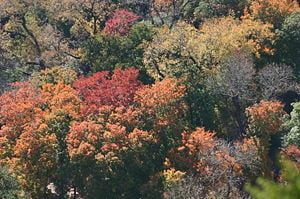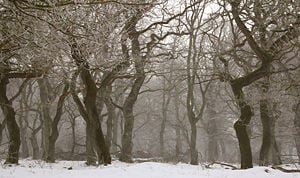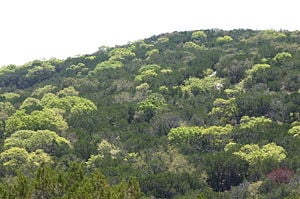Difference between revisions of "Deciduous" - New World Encyclopedia
Rick Swarts (talk | contribs) |
Rick Swarts (talk | contribs) |
||
| Line 58: | Line 58: | ||
==References== | ==References== | ||
{{Reflist}} | {{Reflist}} | ||
| + | |||
| + | * Aerts, R. 1995. The advantages of being evergreen. ''Trends in Ecology & Evolution'' 10(10): 402–407. | ||
| + | |||
| + | * Ewers, F. W., and R. Schmid. 1981. Longevity of needle fascicles of ''Pinus longaeva'' (Bristlecone pine) and other North American pines. ''Oecologia'' 51: 107–115.. | ||
| + | |||
| + | * Labandeira, C. C., D. L. Dilcher, D.R. Davis, and D. L. Wagner. 1994. [http://www.pnas.org/cgi/content/abstract/91/25/12278 Ninety-seven million years of angiosperm-insect association: paleobiological insights into the meaning of coevolution]. ''Proceedings of the National Academy of Sciences of the United States of America'' 91(25): 12278-12282. Retrieved May 23, 2008. | ||
| + | |||
| + | * Matyssek, R. 1986. Carbon, water and nitrogen relations in evergreen and deciduous conifers. ''Tree Physiology'' 2: 177–187. | ||
* Seiberling, S. M. 2005. [http://www.ibiblio.org/openkey/intkey/web/glossary.pdf Glossary of botanical terms used in the OpenKey Project]. ''The Illinois - North Carolina Collaborative Environment for Botanical Resources'', a project of the University of Illinois at Urbana Champaign and the University of North Carolina at Chapel Hill. Retrieved May 23, 2008. | * Seiberling, S. M. 2005. [http://www.ibiblio.org/openkey/intkey/web/glossary.pdf Glossary of botanical terms used in the OpenKey Project]. ''The Illinois - North Carolina Collaborative Environment for Botanical Resources'', a project of the University of Illinois at Urbana Champaign and the University of North Carolina at Chapel Hill. Retrieved May 23, 2008. | ||
| + | |||
| + | * Sobrado, M. A. 1991. Cost-benefit relationships in deciduous and evergreen leaves of tropical dry forest species. ''Functional Ecology'' 5(5): 608–616. | ||
| + | |||
| + | * Weber, W. 2001. ''African Rain Forest Ecology and Conservation: An Interdisciplinary Perspective''. New Haven: Yale University Press. ISBN 0300084331. | ||
[[Category:Life sciences]] | [[Category:Life sciences]] | ||
Revision as of 19:07, 23 May 2008
- For other uses, see Deciduous (disambiguation).
Deciduous means "falling off at maturity" or "tending to fall off" (deriving from the Latin word decidere, to fall off)[1] and is typically used in reference to trees or shrubs that lose their leaves seasonally and to the shedding of other plant structures such as petals after flowering or fruit when ripe. In a more specific sense deciduous means the dropping of a part that is no longer needed, or falling away after its purpose is finished. In plants it is the result of natural processes; in other fields the word has a similar meaning, including deciduous antlers in deer or deciduous teeth, also known as baby teeth, in some mammals, including human children.[2]
Botany
In botany and horticulture, deciduous plants, including trees, shrubs and herbaceous perennials, are those that lose all of their leaves for part of the year. This process is called abscission. In some cases leaf loss coincides with winter - namely in temperate or polar climates. While in other areas of the world, plants lose their leaves during the dry season or during other seasonal variations in rainfall, including tropical, subtropical and arid regions of the world.
The converse of deciduous is evergreen, where green foliage is persistent year round. Plants that are intermediate may be called semi-deciduous, and lose old foliage as new growth begins, others are semi-evergreen[3] and lose their leaves before the next growing season but retain some during winter or during dry periods.[4] Some trees, including a few Oak species have desiccated leaves that remain on the tree through winter; these dry persistent leaves are called marcescent leaves and are dropped in the spring as new growth begins.
Many deciduous plants flower during the period when they are leafless as this increases the effectiveness of pollination. The absence of leaves improves wind transmission of pollen for wind-pollinated plants, and increases the visibility of the flowers to insects in insect-pollinated plants. This strategy is not without risks, as the flowers can be damaged by frost or, in dry season regions, result in water stress on the plant. Nevertheless, there is much less branch and trunk breakage from glaze ice storms when leafless, and plants can reduce water loss due to the reduction in availability of liquid water during the cold winter days.[5]
Leaf drop or abscission involves complex physiological signals and changes within plants. The process of photosynthesis steadily degrades the supply of chlorophylls in foliage; plants normally replenish chlorophylls during the summer months. When days grow short and nights are cool, or when plants are drought stressed, deciduous trees decrease chlorophyll pigment production allowing other pigments present in the leaf to become apparent, resulting in fall color. These other pigments include carotenoids that are yellow, brown, and orange. Anthocyanin pigments produce reds and purple colors, though they are not always present in the leaves but are produced in the foliage in late summer when sugars are trapped in the leaves after the process of abscission begins. Parts of the world that have showy displays of bright fall colors are limited to locations where days become short and nights are cool. In other parts of the world the leaves of deciduous trees simply fall off without turning the bright colors produced from the accumulation of anthocyanin pigments.
The beginning of leaf drop starts when an abscission layer is formed between the leaf petiole and the stem. This layer is formed in the spring during active new growth of the leaf, it consists of layers of cells that can separate from each other. The cells are sensitive to a plant hormone called auxin that is produced by the leaf and other parts of the plant. When the auxin coming from the leaf is produced at a rate consistent with that of the auxin from the body of the plant, the cells of the abscission layer remain connected; in the fall or when under stress the auxin flow from the leaf decreases or stops triggering cellular elongation within the abscission layer. The elongation of these cells break the connection between the different cell layers, allowing the leaf to break away from the plant, it also forms a layer that seals the break so the plant does not lose sap.
A number of deciduous plants remove nitrogen and carbon from the foliage before they are shed and store them in the form of proteins in the vacuoles of parenchyma cells in the roots and the inner bark. In the spring these proteins are used as a nitrogen source during the growth of new leaves or flowers.[6]
Plants with deciduous foliage have both advantages and disadvantages compared to plants with evergreen foliage. Since deciduous plants lose their leaves to conserve water or to better survive winter weather conditions they must regrow new foliage during the next suitable growing season; this uses more resources which evergreens do not need to expend. Evergreens suffer greater water lose during the winter and they also can experience greater predation pressure, especially when small. Losing leaves in winter may reduce damage from insects; repairing leaves and keeping them functional may be more costly than just losing and regrowing them.[7]
Deciduous woody plants
The deciduous characteristic has developed repeatedly among woody plants. Trees include Maple, many Oaks, Elm, Aspen, and Birch, among others, as well as a number of coniferous genera, such as Larch and Metasequoia. Deciduous shrubs include honeysuckle, poison oak, and many others. Most temperate woody vines are also deciduous, including grapes, poison ivy, virginia creeper, wisteria, etc. The characteristic is useful in plant identification; for instance in parts of Southern California and the American Southeast, deciduous and evergreen oak species may grow side by side.
Periods of leaf fall often coincide with seasons: winter in the case of cool-climate plants or the dry-season in the case of tropical plants[8] , however there are no deciduous species among tree-like monocotyledonous plants, e.g. palms, yuccas, and dracenas.
Regions
Deciduous forests can be found in sections of: North America, South America, Europe, Asia, Australia, and Africa (Madagascar)(Bahamas). Forests with a majority of tree species that lose their foliage at the end of the typical growing season are called deciduous forests. These forests have distinctive ecosystems, understory growth, and soil dynamics.[9]
Two distinctive types of deciduous forest are found growing around the world.
Temperate deciduous forest biomes are plant communities distributed in America, Asia and Europe. The have formed under climatic conditions which have great seasonable temperature variability with growth occurring during warm summers and leaf drop in fall and dormancy during cold winters. These seasonally distinctive communities have diverse life forms that are impacted greatly by the seasonality of their climate, mainly temperature and precipitation rates. These varying and regionally different ecological conditions produce distinctive forest plant communities in different regions.
Tropical and subtropical deciduous forest biomes have developed in response not to seasonal temperature variations but to seasonal rainfall patterns. During prolonged dry periods the foliage is dropped to conserve water and prevent death from drought. Leaf drop is not seasonally dependent as it is in temperate climates, and can occur any time of year and varies by region of the world. Even within a small local area there can be variations in the timing and duration of leaf drop; different sides of the same mountain and areas that have high water tables or areas along streams and rivers can produce a patchwork of leafy and none leaf trees.[10]
ReferencesISBN links support NWE through referral fees
- ↑ Online Etymology Dictionary. Retrieved 2008-02-08.
- ↑ Gause, John Taylor (1955). The complete word hunter, A Crowell reference book. New York: Crowell, p. 456.
- ↑ http://www.ibiblio.org/openkey/intkey/web/glossary.pdf page 22.
- ↑ Weber, William. 2001. African rain forest ecology and conservation an interdisciplinary perspective. New Haven: Yale University Press. page 15.
- ↑ Lemon, P. C. (1961). Forest ecology of ice storms. Bulletin of the Torrey Botanical Club 88 (21).
- ↑ Srivastava, Lalit M. (2002). Plant growth and development. Hormones and environment. Amsterdam: Academic Press, p. 476. ISBN 0-12-660570-X.
- ↑ Labandeira, C.C. and Dilcher, D.L.; Davis, D.R.; Wagner, D.L. (1994). Ninety-seven million years of angiosperm-insect association: paleobiological insights into the meaning of coevolution. Proceedings of the National Academy of Sciences of the United States of America 91 (25): 12278-12282.
- ↑ Cundall, Peter (2005). Flora: The Gardener’s Bible: Over 20,000 Plants. Ultimo, NSW, Australia: ABC Publishing. ISBN 073331094X.
- ↑ Röhrig (ed.), Ernst and Bernhard Ulrich (ed.) (1991). Temperate deciduous forests, Ecosystems of the world, 7. Amsterdam: Elsevier. ISBN 0-444-88599-4.
- ↑ Bullock, Stephen H. and J. Arturo Solis-Magallanes (March 1990). Phenology of Canopy Trees of a Tropical Deciduous Forest in Mexico. Biotropica 22 (1): pp. 22–35.
- Aerts, R. 1995. The advantages of being evergreen. Trends in Ecology & Evolution 10(10): 402–407.
- Ewers, F. W., and R. Schmid. 1981. Longevity of needle fascicles of Pinus longaeva (Bristlecone pine) and other North American pines. Oecologia 51: 107–115..
- Labandeira, C. C., D. L. Dilcher, D.R. Davis, and D. L. Wagner. 1994. Ninety-seven million years of angiosperm-insect association: paleobiological insights into the meaning of coevolution. Proceedings of the National Academy of Sciences of the United States of America 91(25): 12278-12282. Retrieved May 23, 2008.
- Matyssek, R. 1986. Carbon, water and nitrogen relations in evergreen and deciduous conifers. Tree Physiology 2: 177–187.
- Seiberling, S. M. 2005. Glossary of botanical terms used in the OpenKey Project. The Illinois - North Carolina Collaborative Environment for Botanical Resources, a project of the University of Illinois at Urbana Champaign and the University of North Carolina at Chapel Hill. Retrieved May 23, 2008.
- Sobrado, M. A. 1991. Cost-benefit relationships in deciduous and evergreen leaves of tropical dry forest species. Functional Ecology 5(5): 608–616.
- Weber, W. 2001. African Rain Forest Ecology and Conservation: An Interdisciplinary Perspective. New Haven: Yale University Press. ISBN 0300084331.
Credits
New World Encyclopedia writers and editors rewrote and completed the Wikipedia article in accordance with New World Encyclopedia standards. This article abides by terms of the Creative Commons CC-by-sa 3.0 License (CC-by-sa), which may be used and disseminated with proper attribution. Credit is due under the terms of this license that can reference both the New World Encyclopedia contributors and the selfless volunteer contributors of the Wikimedia Foundation. To cite this article click here for a list of acceptable citing formats.The history of earlier contributions by wikipedians is accessible to researchers here:
The history of this article since it was imported to New World Encyclopedia:
Note: Some restrictions may apply to use of individual images which are separately licensed.



